Latest News
February 1, 2008
By Al Dean
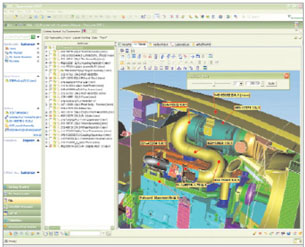 The new Teamcenter user interface adopts the industry-standard Outlook look and feel but adapts itto the special tasks and requirements of the design and manufacturing specialist. |
If you are unfamiliar with Teamcenter, we’ll forgive you for thinking that Siemens Product Lifecycle Management (PLM) Software’s flagship PLM system is one big product. It’s not.
Implementation of this system effectively involves setting up discrete products — separate databases and such — albeit products that can communicate with each other efficiently. So, taking this into account, Siemens PLM has gone back to the drawing board and redrawn the architecture of the system to run on a single platform and database. It will now use that “unified architecture” as the basis for upcoming development.
This also gave the development team a chance to redevelop key aspects of the system using a service-oriented architecture (SOA), meaning Teamcenter is now configured to allow greater communication between other applications, irrespective of vendor or operating environment. For the end user it means you should be able to hook together discrete SOA-based applications (here I’m thinking, PLM with ERP and such) without the traditional pain.
O.K. So, there’s a united architecture. While the system is too vast and all-encompassing to do justice to the entire release, we can take a look at what else Teamcenter 2007 brings to the table. A good place to start is the user experience and its overhauled interface.
Gone are the disparate UIs for each area of functionality — the whole thing has been redeveloped using a style guide that will be familiar to many readers. While the tasks and workflow might be different from Outlook, the user interaction basics are much the same. The UI is divided up into subsections with many of your frequently used operations and tasks available pervasively, and you can dig in as deep as you want.
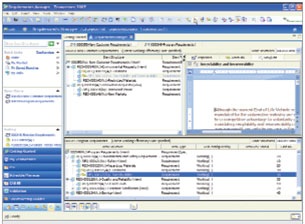 The new Management tools within Teamcenter allow you to use requirements as the basis for a development process and maintain full traceability back to the very root document. It also lets you track the impact of any changes to that root source as you move forward. |
Requirements Planning
I saw many impressive things at the Teamcenter 2007 launch, but what jumped out at me were the Requirements Planning tools. Siemens PLM Software (formerly UGS) has made great strides in the task of linking data management and product development together with knowledge and rules-based design. The work done in NX reflects the ability to create intelligence in your 3D model from the very beginning and to maximize reuse. What has been missing (both in the Siemens offering and the industry at large) is the ability to create links between the requirements documents that are generated in the very formative stages of design and the digital data — created later on in the process — that defines the product.
Teamcenter 2007 begins to address this. You start with a specification document (in Word, for example). Teamcenter then parses that document and finds the requirements defined within it (using a text filter/search) and creates a structure of discrete, manageable entities within the Teamcenter database that contain information about each.
What’s intriguing is that not only do you have a link back to the very source of a development project, but those requirements are managed, change controlled, and secure as you move onward. Each can be linked to further documents and entities (such as CAD parts if you need to assign a requirement to a specific part or subsystem). These can then be used as the driving factor for further development work.
Project management
The new Portfolio, Program, and Project Management tools (given the nifty name of PPPM) follow on nicely from the requirement capture tools. They allow you to take a product development project and combine it with the one factor that’s always in short supply in such endeavours — time. Let’s split them into their constituent parts beginning with Portfolio. The new tools allow you to investigate your current projects at a very high level, see where resources are used or not used, and whether new projects are feasible with existing resources (in terms of staff, resource, materials, and such). They also allow you to use company standard metrics to see how your portfolio of work is measuring against corporate requirements, whether they be things like improving sustainability and increasing innovation, or more concrete measures such as reducing material usage and waste, gaining market share, etc.
The next is Program and Project management. Teamcenter now has a vast array of scheduling and calendaring and a fully featured project management tool that allow you to create timeline-based tasks with constraints and dependencies to ensure that your team is aware of the requirements, and when and where things need to be completed. This is all integrated into Microsoft Project, if that’s your tool of choice, but I would imagine with the improved control and greater depth of knowledge available in Teamcenter that might fall by the wayside.
These project plans are of course linked to workflows that are used for change processes as well as more general approvals and such. For the manager, the ability to dive in and assign resources to specific tasks, then follow up with live reporting on the current state of a project means that a closer eye can be kept without distracting from day-to-day work.
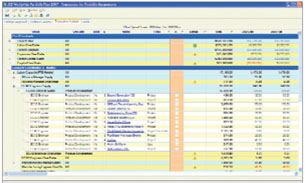 The new Portfolio planning tools allow you to extract as much financial and costing information about your projects as you need — these reports are fully customizable and can give management avery quick way to see how costs are spread across an organization and its activities. |
Engineering Process Management
Once you have a project plan ready to execute, the next stage is the definition, design, and engineering stage; and that, for many of our readers, will be the sweet spot. So what does the 2007 release bring to our core group? The answer is that while Teamcenter has always supported widespread integration with systems outside of the Siemens domain (i.e., NX and Solid Edge), it has been expanded upon for this release.
Support has not only been added for the gamut of 3D modeling and design systems, but also for ECAD tools, CAM and NC, CAE and simulation, and many more applications and systems used in the development of many products. It’s now possible to store, manage, and control almost every dataset that is used to define a product from core fundamentals such as CAD data and simulation datasets to results information and more. It is also clear that this rich source of data is going to be needed by a growing number of users, beyond the traditional authoring and managing users of old. With this in mind, now there are tools to allow the user to work with, visualize, and inspect the data on his own terms. Tools for configuration and context management and lifecycle representation all assist in making data available and easily understood so it can be acted upon or reused without requiring any additional interpretation.
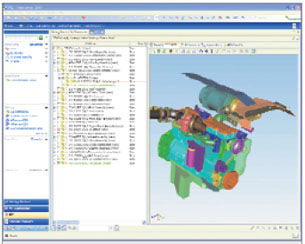 The new BOM edit and control tools are going to make life much easier forthose used to work arounds, exports to Excel, and reimport shenanigans.The system allows you to make the changes and modifications you needbut does so in a controlled, managed, and traceable environment. |
BOM wrangling
It never fails to surprise me, on reflection, how critical the bill of materials (BOM) is to a product. Without this list of components, resources, etc., in many cases the whole project is doomed to failure. The more complex the product or the production process, the truer this becomes — and anyone who works with complex products and processes knows that wrangling these buggers is a nightmare if you’re trying to reconcile the differences in needs between design, engineering, manufacturing, and suppliers, etc.
Teamcenter 2007 introduces a number of core tools that allow you to do that in a more intelligent manner. These range from new methods of editing complete structures using a Tabular method to Part Attributes that enable you to include metadata such as Make/Buy, reference designators, units of measure, etc. For those dealing with revision issues, the new ability to evolve (up rev) both the part and CAD independently is going to save a lot of time and effort usually spent trying to work around such issues.
Finally, for those working with BOM data in a collaborative manner, the new BOM redlining tools allow you to track changes to part substitutions and removals, changes, and attribute values edits in a visual manner. Finally for BOMs, support for alternate and substitute parts has been made consistent with the current STEP standard requirements.
Simulation data management
I’m rapidly running out of space for this review but there is one area I really want to fit in and that’s the integration of simulation and its associated data within Teamcenter. Simulation use is growing at a huge rate, but more often than not, its use is outside of the data management system. When you consider that this is critical information in terms of making decisions on the direction of product development, to have that data outside of your control and unmanaged seems counterproductive.
The Simulation Data Management tools address this problem. There’s now a simulation-specific product structure available in any product model enabling you to generate BOMs, manage configurations and variants, and run simulations. Of course, one of the critical benefits is the ability to ensure that when part or assembly geometry updates, if it’s required, the associated simulation studies are also updated. As a result, Teamcenter 2007 allows greater revision and version control for analysis datasets. Finally, for simulation, the already impressive visualization tools that are now a core part of every Teamcenter installation have the ability to handle simulation datasets, whether that’s FEA, CFD, or motion-based analysis.
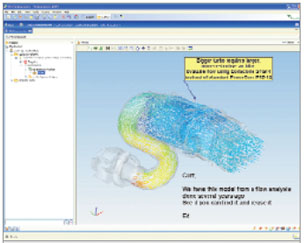 Visualization is pervasive in Teamcenter and has been extended to allowusers to interact with, inspect, and collaborate on the basis of simulationdatasets from FEA, CFD, and motion studies. |
Bulletproof plm
Siemens had a challenge on its hands. In the PLM world, Teamcenter is the clear leader in terms of active users out there (three million users or more). But while it has a position of leadership, the existing product wasn’t a single offering at all, rather several key products bolted together: not ideal. Rationalizing and rearchitecting into a common platform was inevitable. What I didn’t expect was the extent to which this has been accomplished for the new company’s first major release. There are enhancements all across the board and there is some real innovation on display here. Data management doesn’t get all the glory of 3D design, but it is essential, and new introductions like requirement planning, greater simulation support, and even editing and working with multiple BOM representations are real tools for people doing a real job. I love the concept behind Requirement integration. Consider requirements as the very fundamentals of yo ur product: When changing something as simple as a word document that is critical to the success of the product can be controlled and traced, the concept is incredibly powerful. This allows you to create a link between the actual requirements document and the geometry that defines that component or subassembly. This can be done to a granular level, so a requirement such as a dimension or a functional requirement (such as BHP, power output, etc.) can be linked directly to the geometry and integrated into a parametric equation or design rule that defines its form. Of course, if the requirement document changes, the system is aware of the link and can update the geometry to accommodate the new requirement.
There is a great deal more to this release, from compliance to supplier management — and all across the board. If your interest has been piqued, I would suggest you explore further, whether you’re an existing Teamcenter user, whether you have an interest in such things, or are looking to adopt a bulletproof data and lifecycle management system. Teamcenter 2007 impresses at a fundamental level.
More Info
Siemens PLM Software
Plano, TX
siemens.com/plm
Al Dean is technology editor at MCAD Magazine, a UK product development and manufacturing technology journal (mcadonline.com) and is editor of Prototype magazine (prototypemagazine.com). You can send comments about this article to [email protected].
Subscribe to our FREE magazine, FREE email newsletters or both!
Latest News
About the Author
DE’s editors contribute news and new product announcements to Digital Engineering.
Press releases may be sent to them via [email protected].






